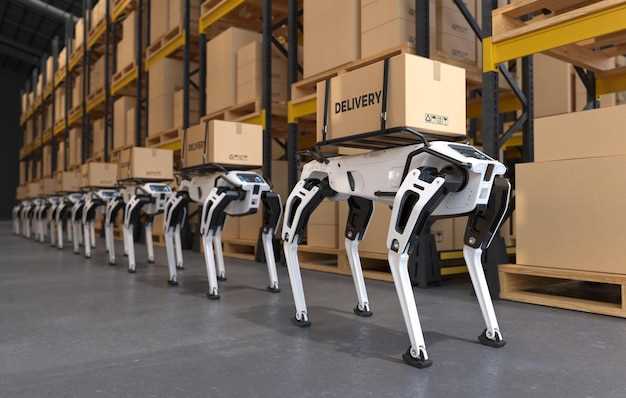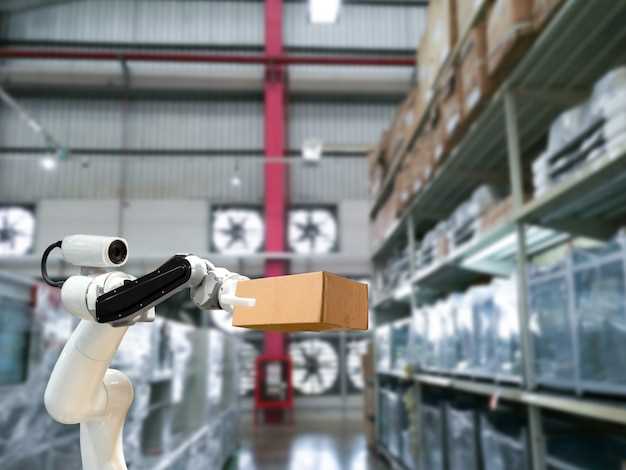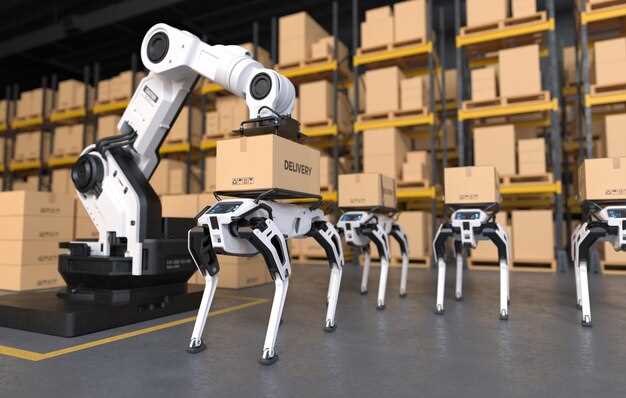Deploy a modular intelligent automation stack today, fully integrated with your ERP, focusing pe sensors and autonomous assets to address bottlenecks in picking and packing. Start with a one-zone pilot, gather real-time insights on throughput, and scale smoothly across the workplace as results prove viable.
In practice, a quick teardown of existing processes reveals where automation delivers the most value: repetitive forklift tasks, route planning for a camion fleet, and the handling of inbound goods. A clean break between manual and automated flows helps unify safety and productivity, while still keeping workers engaged on higher‑skill tasks. This mix keeps the workplace safe and productive, versus human effort is favorable when applied in the right zones.
In 2025, expect intelligent perception at the edge to drive decisions, reducing latency between sensing and action. approximately 60–70% of repetitive motions can be automated with semi-autonomous vehicles, teleoperation, and sensor fusion. Vendors offer modular stacks that address cross-dock routing, pallet handling, and dock‑door sequencing.
To address the workforce transition, implement a clear change plan: open lines of feedback, scheduled training, and a stepwise rollout. This addresses the challenge of scaling automation across teams, and provides operators with predictable tasks and makes the data actionable. It was common that operators were hesitant at first, but hands-on tutoring reduced resistance and accelerated adoption. It is crucial to track the impact on safety, quality, and throughput, and later share those results with teams to maintain momentum.
As you move from pilot to production, track throughput, equipment utilization, and safety incidents to quantify impact. A disciplined teardown of results helps you compare intelligent automation scenarios versus manual operations and address any remaining bottlenecks.
Key Trends Shaping Warehouse Automation in 2025
Recommendation: deploy modular robotic cells focused on fast pick in high-velocity zones, tied to a scalable automation system and a connected WMS. Target a 12–18 month ROI and a 20–35% lift in throughput, especially for orders with tight deadlines where demand is high.
Deep advancements in sensing, AI-driven routing, and gripper engineering empower specific models of robotic arms to handle mixed SKUs with minimal damage. The intricate control loops, validated in pilot lines, cut item damage by 30% and reduce cycle time by 15%.
Goods-to-person workflows benefit from collaborative robots in peri-dock cells combined with shift to pick-to-light and zone-based slotting. In 2025, teams that combine goods-to-person with automation like wearable devices report 18–28% error reductions and smoother labor dynamics.
Trucking connections: feed inbound truck data directly to ERP and WMS, enabling real-time dock scheduling and a 25% reduction in dwell times. For a client with complex SKU mixes, a tailored automation system reduces handling steps by 35% and boosts on-time loading.
Competition among integrators drives investment in modular cores and scalable controllers. Having a flexible, industrial-grade robotic stack supports like-for-like item handling and reduces downtime by 20% through predictive maintenance.
Shift in roles requires engineering-led training: technicians monitor sensors, tune models, and perform preventive maintenance. This approach preserves jobs by elevating staff into higher-skill oversight, data analysis, and systems integration.
Industrial ecosystems benefit from standardized interfaces and supplier networks, enabling quick swaps of components while maintaining system performance. Start with a 90-day pilot in one facility, then scale to three sites within a year, guided by data from KPIs such as throughput, accuracy, and uptime.
Autonomous Mobile Robots: Navigation, charging, and safety protocols
Recommendation: Start with a pilot fleet of 3-5 robots in a defined warehouse block, install fixed charging docks, and lock in a mapped route library. This setup makes integration easier, aligns with government standards, and suits facilities of that size. This configuration is a good suit for mixed facility sizes.
Navigation for agvs and autonomous mobile robots relies on SLAM, lidar and camera sensors, and robust path planning. The robotic stack integrates with the warehouse management system to coordinate orders and inventory across multiple aisles. Each robot maintains a local map and shares updates with a central planner to avoid collisions in multiple aisles. Establish a standard map versioning cadence, with updates every 60-120 seconds during steady operation and a fast replanning loop under 200 ms when a dynamic obstacle appears. Design the layout to assign clear lanes for robots and keep humans aware of the robotic traffic itself.
Charging strategy: Implement two-tier charging–opportunistic charging during idle moments and dedicated docking when the robot reaches 15-20% remaining range. Provide enough docks to cover at least 25-35% of the fleet simultaneously and consider swappable batteries to cut downtime. Target 80% charge within 45-60 minutes; monitor battery health with predictive analytics and flag batteries showing capacity loss early. Build a stock of additional batteries to cover peak demand and maintenance windows.
Safety protocols: Apply three layers of protection. Device-level safety includes emergency stop, automatic speed compliance, and safe docking procedures. Process-level safety uses geofences, restricted zones, and lockout procedures for maintenance. Human-robot interfaces require clear signage, hands-on training, and regular drills; implement a kill-switch for overrides and maintain an incident log for ongoing improvement. Align with national and sector standards to prepare for audits from government inspectors and international customers across countries.
Analytics and applications: Track throughput, pick rate, dwell times, and maintenance cost. Use analysis to compare scenarios across multiple facilities and to quantify a leap in warehousing efficiency. The system itself should account for the size and complexity of facilities and support technologies that enable goods-to-person applications. When the fleet expands, scale to additional sites and new countries, ensuring the combined data feed supports decision-making and ROI accounting for both robots and operators.
WMS and Robotics Integration: Data flows, API access, and real-time visibility
Implement a single API layer that exposes WMS data to robotics platforms, enabling clean data flows and real-time visibility from receipt to dispatch.
Data streams includes orders, inbound receipts, locations, task queues, inventory levels, and the current statuses of vehicles and drones. Use event streams (MQTT, REST webhooks) to guarantee movements and task changes stay synchronized across all devices and interfaces, including user-facing faces.
APIs should offer REST and streaming access with RBAC, API keys, and versioning; provide adapters to connect diverse platform ecosystems and expose consistent data models for tasks, locations, and exceptions.
Online dashboards deliver real-time visibility across the factory and across countries, showing live locations of vehicles and drones, task progress, and exception alerts; operators can drill down by zone, device, or movement to identify bottlenecks quickly.
Start with a small pilot in two facilities to map data definitions, approve data includes, and validate end-to-end flows; document the data dictionary, align ownership, and set targets for metrics like dock-to-dock times and asset utilization.
Security and governance protect data as it moves between WMS and robotics systems: encrypt data in transit and at rest, enforce strict access controls, and maintain audit logs for API usage and changes. This setup also adapts to change as operations scale.
The result is a platform that supports very tight coordination, significant performance gains, and exceptional situational awareness for teams facing complex, multi-site operations. References: researchidtechexcom
Robot-Assisted Picking and Sortation: Workflow optimization and ergonomic considerations
Recommendation: Implement ground-based robot-assisted picking cells with modular, task-specific end-effectors and a data-driven planning layer that addresses bottlenecks in warehousing. This presents a clear difference in throughput and ergonomics, and it will reduce unnecessary movements and operator fatigue, saving cycle time and distance.
- Layout and planning: Map the item mix to a smaller set of dedicated zones; design ground-based pick cells with minimal reach; group SKUs by specific families to address bottlenecks, saving travel distance and streamlining the flow. A data-driven assessment can cut cycle time by 25-40% and shrink footprint through modular, reconfigurable modules.
- Motion control and end-effectors: Deploy task-specific grippers and suction for smaller items; calibrate to handle delicate goods without damage; end-effectors should swap quickly to expand capabilities. This will reduce mis-picks and, however, keep collision risk low with clear zone demarcations.
- Sortation and routing: Implement parallel sort lanes with integrated sort modules to streamline post-pick flows and improve batch accuracy. Use real-time triggers to address deviations, supporting distributors who rely on rapid parcel grouping. The difference is evident in throughput and accuracy gains across shifts.
- Ergonomics and operator well-being: Install adjustable-height pick stations, forearm supports, and anti-fatigue flooring; limit reach distances to reduce strain; provide scheduled micro-breaks and intuitive displays. These changes significantly reduce fatigue and improve sustained performance across the fleet.
- Data, metrics, and continuous improvement: Capture handling time, dwell time, and travel distance per pick; run a data-driven dashboard to compare baseline with ongoing results; monitor fleet utilization and pick accuracy to guide planning iterations and immediate course corrections.
- Implementation and safety: Start with a focused pilot in high-volume areas; collaborate with distributors to validate workflows; ensure IT integration and regular preventive maintenance; address issues immediately and iterate the setup based on concrete feedback from operators.
Human–Robot Collaboration: Reskilling, role evolution, and change management

Recommendation: implement a 12-week in-house reskilling sprint that maps each job to robot-assisted tasks, starting with first pilots in picking and packing and expanding to thousands of roles as demand data is gathered. We gather feedback weekly to steer the rollout.
Reskilling path becomes becoming proficient in composite workflows that blend human judgment with robot support. Each track uses micro-lessons, hands-on practice, and slam-based simulations that include material-handling scenarios. The size of the program scales from a pilot site to in-house training across locations, enabling thousands of tasks that serve customers daily and lift output. We utilize feedback loops to adjust content and timing. Emerging automation options are integrated when pilots prove stable.
Role evolution centers on new job profiles such as automation liaison, robot-ops supervisor, and in-house change manager. The first cohort participates in a cross-functional table to decide task ownership and accountability at the workplace. Each site runs a short sprint with on-floor coaching, then a broader deployment. The departure of old tasks is managed with transparent transitions and targeted coaching to keep morale high.
| Rol | Skill focus | Training type | Output impact | Time to proficiency | Site/Format |
|---|---|---|---|---|---|
| Order picker | slam-based routing, material handling | hands-on + simulations | 15–20% uplift in throughput | 4–6 weeks | in-house |
| Robot-operator liaison | level-4 decisioning, fault diagnosis | micro-learning + on-floor coaching | 10–12% reduction in downtime | 6–8 weeks | in-house |
| Maintenance technician | sensor data, preventive maintenance | remote labs + on-site | uptime 98%+, fewer outages | 8–12 weeks | in-house |
| Change-manager | change-readiness, training governance | workshops + mentoring | faster adoption, lower task departure | 6–8 weeks | in-house |
Implementation timeline and governance: start with a 12-week pilot at two sites, then scale to all facilities within 9–12 months. Weekly demos show progress, monthly reviews adjust targets, and a dedicated change-management team coordinates training, staffing, and process tweaks. In-house teams will utilize data dashboards to monitor skill gaps, training completion, and impact on lead times and order accuracy.
Cost, ROI, and Total Ownership for Robot Fleets in 2025

Begin with a concrete recommendation: run a 12-week pilot on a high-repetition picking line to quantify time-to-value and prove ROI before scaling the fleet.
Build a lifecycle cost model: costs cover upfront hardware, installation, software licenses, WMS integration, energy, spare parts, ongoing maintenance, and training. Break down the contents of the model as hardware, software, integration, service, and energy, and estimate costs around each phase to avoid surprises.
Focus on ROI drivers that matter to the client: throughput gains, reduced labor costs, fewer errors, and predictable maintenance. The solution should clearly show how networked robots work together, how the team collaborates with operations, and how repetitive tasks are redeployed to free people for higher-value work, particularly when shifts run at full speed and especially during peak periods.
Regulatory reality heads-up: align with regulations and government guidelines; in malaysian facilities, engage local authorities early and map certifications, safety audits, and data-handling rules into the deployment plan.
Ownership and governance: establish a close client–vendor team with clear roles, set a joint budget that covers initial deployment and ongoing refreshes, and monitor the network’s health via a monthly scorecard. Track the contents of your total ownership–costs, spare parts, support, energy–and prepare for renewal or scale, keeping an eye on regulatory changes that could affect uptime and payloads. The pursuit remains to balance cost containment with performance gains and to manage the challenge of downtime and variability, ensuring time-to-value remains on target while each additional robot adds measurable value.

 The Robot Revolution – Warehouse Automation Trends for 2025">
The Robot Revolution – Warehouse Automation Trends for 2025">
